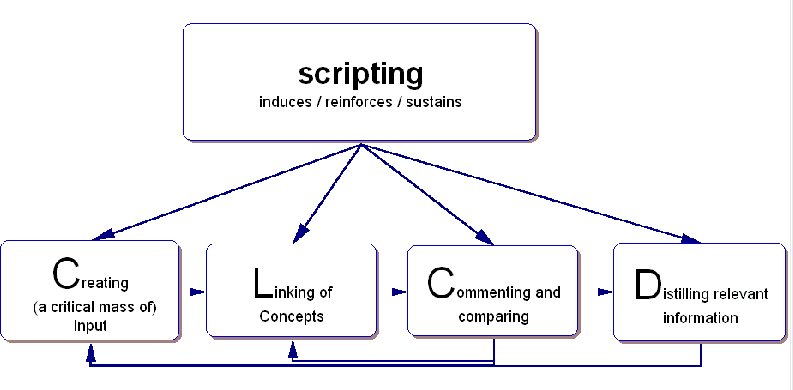ABAHCOCOSUCOL
Definition
- ABAHCOCOSUCOL get's the prize for the longest acronym and has been invented by Michele Notari.
- ABAHCOCOSUCOL means Action Based, Hypertext - Constructive, Computer Supported, COLlaborative
The model
From (Notari 2003) "cut and paste":
Scripting for ABAHCOCOSUCOL can be cut in four phases:
- Initiation
- Comparison
- Re-grouping
- Discussion
An initiation phase leads students into the problem and gives them an indication for an appropriate first action. For this phase, there is no big difference between an ABAHCOCOSUCOL and conventional teaching. The comparison phase is very important and should start immediately after the unit is up and running. Here a difference from conventional constructive learning can be seen, where a comparison between the work of all members of the learning community is difficult to set-up, and such an environment of commenting and comparing cannot be easily created. The comparison phase then leads into the re-grouping of the produced work, which aids in the construction of mental models of the different concepts and is fruitful for learning. This sets the stage for the discussion phase, and the feedback and comment culture described above leads to a re-grouping of the content.
These phases can be repeated more than once. At the end of the learning unit a discussion should give students the opportunity to formulate and discuss different opinions or concepts. The positive feedback cycle of production, comparison, and re-grouping can also be formulated in the following way:
The scripting input leading to the creation of input is important at the beginning of the unit. Here we call it creation of a critical mass of input. Students should immediately compare and comment the works of the other to augment the interactions between the learning community. Scripting should induce students to publish what they have produced as soon as possible and it should be mentioned that there will be an 'evolution' of the text during the unit due to the comments and questions of the other members of the community. The 'critical mass' of input at the beginning is important for the start of interactions and creation of the communication culture. Of course other 'creating inputs' can be made during the learning unit for instants when new questions rise.
The linking of concepts is important for the awareness of the common goal and the cross-linkage of the treated concepts of the unit. The learning community creates one collaboratively elaborated hypertext where the different pages are interwoven and linked together. Creating links sustains the awareness of the community and gives a basis for the comments and comparisons produced as a further action of the students. Finally the distillation and re-grouping of relevant information leads to an self evaluation of the product of the learning community.
Technology used
A wiki
The unstructured collaboration tool was well-adapted to our needs. It turned out to be easy enough to use after a 20 minute introduction, it was stable enough to permit the focalisation of content production, and it was open enough to adapt its structure and strategies while the units were running. Furthermore, it permitted a good level of collaboration without other communication tools such as forums or chat groups, and it could be adapted to different subjects, and to fit the needs of the different classes. Students liked to publish articles but they did not like so much to comment the work of other members. The creation and support of a feedback culture turned out to be important for learning success. Scripting should intervene here and support the communication culture. Swiki turned to be an optimal tool for small and medium projects. We did not test any bigger learning projects with long inputs about different subjects. We can imagine that such project need different conception and a more structure within the produced document. We tried to sustain input quality and quantity without regarding structure. (Notari 2003: 103)
Tips for teachers
The following guidelines should be considered by teachers who are setting up a Swiki for ABAHCOCOSUCOL:
- Watch the structure of the entry page
- Be aware of editing conflicts
- Give a short introduction to the tool
- Be careful of signatures and references, and mention it whenever it is possible
- Prepare the main inputs and the guiding scripts
- Build a hypothetical framework of core mechanism(s) to foster the pedagogical goal and the actions of the students for every sub unit of you course
- Create a feed-back culture from the beginning on. Induce students to interfere and intervene in a constructive way in the actions of other members of the class
The size of the Project has a big impact on the structure of the constructed hypertext. While for smaller projects (one or two classes working for five to eight lessons) no specific structuring is necessary for larger projects it is important to steer the development of the hypertext in order to build up indicators for main concepts and additional information.
References
- Michele Notari (2003),
Scripting Strategies In Computer Supported Collaborative Learning Environments, Mémoire présenté pour l'obtention du DES STAF, TECFA FAPSE, Université de Genève
- Notari, Michele (2006). How to use a Wiki in education: 'Wiki based effective constructive learning', Proceedings of the 2006 international symposium on Wiki, PDF. (Similar ideas 3 years later, unfortunately he dropped this very unusual acronym...)
